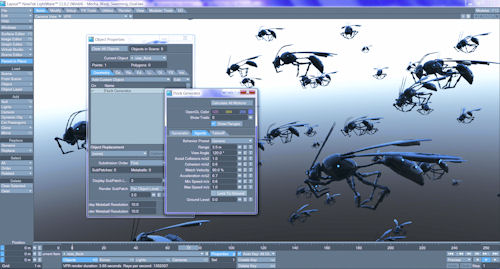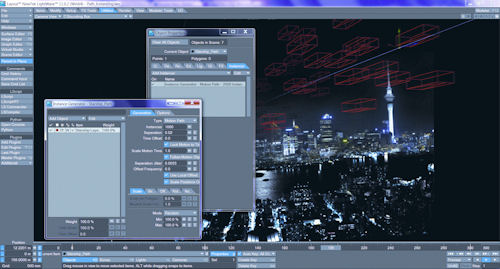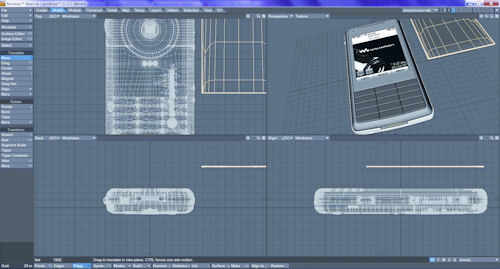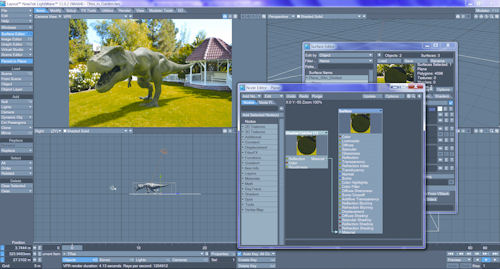Latest News
September 1, 2012
By Mark Clarkson
Despite age-old hints and promises to the contrary, LightWave remains two distinct applications: Modeler and Layout. Modeler is where you create your geometry. Layout is for everything else—rendering, animation, lighting, and so forth. I don’t mind this separation of the workflow, but it’s something that continues to chafe on the community.
I’ve always liked LightWave’s modeler, which is fortunate, because it’s still the same modeler as was in version 10. And version 9. However, the company says version 11.5 will include a number of new modeling features.
For the last several releases, NewTek has been pouring its resources into Layout, improving the rendering workflow, adding better cameras and lights, fur, etc. True to form, that’s where it’s put all the big improvements this time.
Installation Woes
I started hitting hiccups before I got a chance to run the program. Upon installation, I found the resources—models, scenes, textures, etc.—were on the disc in a two-part Zip archive. Windows does not handle multi-part archives natively, so my only options (and the actual procedure recommended in the docs) were to download and install third-party software, or use the command line mode to manually combine the two parts into a single file, then unzip them. Are you kidding me? I really hope my problems were the result of my getting a very early release of the program.
Likewise, the help file loaded only blank pages. It turns out that the help files don’t like Google’s Chrome browser. Once I reverted to Internet Explorer, I found the help files were actually for version 10. Despite the application having been shipping for half a year, there are no current help files. Version 11’s help consists of addenda in PDF format. Adding insult to injury, the web-based help option on the help menu took me to a non-existent website.
When questioned about the installation and documentation issues, Rob Powers, president of the LightWave 3D Group, responded that the content, documentation, and files are now distributed with a digital download. He also says the company’s new site is being updated to include more support, including video tutorials and documentation files.
Instancing, Flocking and Physics
LightWave version 11 introduces Instancing—a way to create lots of copies of a single mesh without the usual memory overhead. You could use instancing to cover a tabletop in ball bearings or machine screws, for example, or to create a vast array of cell phones stretching to the horizon. The difference between, say, a single instance of a 1.6 million-polygon object and 500 instances of the same object is only on the order of 2 or 3MB. That’s not to say that those extra 499 meshes don’t impart a performance hit when it comes time to display them onscreen—I definitely felt it—but the memory hit is nil.
 |
| LightWave’s new Flock Generator automatically creates animated flocks of objects—here, a swarm of robot wasps. |
These instances don’t have to be identical copies of the original. You can make them quite different from one another by adding random scaling, positioning and rotation, as well as applying different materials.
The new Flocking feature allows you to create large groups, swarms, flocks or herds of objects that move through your scene in a cohesive way—either following a path, or chasing or avoiding various goals. These flocks can be made up of static meshes, or they can use objects with animated behaviors.
If you ever feel like smashing your models, you’ll be happy with LightWave’s new Bullet Physics. Bullet is an open-source physics engine, also available in Blender, Cinema 4D and other 3D applications. It is great for bouncing balls, collapsing towers or, more practically, for scattering a ton of bolts across a tabletop without having to place each one individually.
 |
| LightWave’s instancing creates hundreds, or even thousands of “clones” of an object without the memory overhead. |
Modeler has a new tool called Fracture, designed to support Bullet Physics by automatically breaking up your solid models into little bits so that Bullet can explode or collapse them. A simpler version of Fracture is available within Layout.
Render Buffer Enhancements
It’s often useful, and sometimes necessary, to export different render passes separately. When the art director wants “more shine” or a deeper shade of red, for example, having separate render passes to work with—reflection, specularity, diffuse color, etc.—lets you quickly tweak the final results in Photoshop rather than resetting and re-rendering your scene.
 |
| LightWave’s modeler remains fast, easy to use—and essentially unchanged for some time. |
LightWave has long had the ability to render different passes to separate layers in a layer Photoshop file, but you had little control over them. LightWave 11’s Compositing Buffer export panel (which is hiding under image filters, rather than as an output option) gives you control over which passes to render and which objects to include. Your checkable options include everything from the normal (reflections, shadows) to the arcane (x and y motion, object ID). For some reason, though, my ambient occlusion passes were borked.
You can also create and save your own named presets, rather than checking and unchecking dozens of boxes with every render.
Other Goodies
LightWave 11 now supports industry-standard Python scripting. Python appears to have full access to LightWave innards, though documentation beyond a couple of example scripts, is, not surprisingly, hard to come by.
LightWave’s VPR real-time preview has been tweaked a bit. It now shows lens flares, for example. Even better, it allows you to easily locate materials (or surfaces) in the Surface Editor by clicking on them in the VPR window.
LightWave’s Print Assistant utility has been improved. It has more presets, and is generally easier to use.
The new Shadow Catcher makes it easier to integrate your renders into existing photographs and animations. Shadow catchers render the shadows and reflections of your scene, and nothing else, so you can lay one down to match the floor in your background photo—and the resulting render casts realistic shadows, tying your objects into the background.
 |
| The new Shadow Catcher helps seamlessly integrate your objects into real-world backgrounds. |
There are a lot of little improvements. The curve and node editors have been cleaned up and made easier to use. All of the sampling controls have been moved to a central location in the camera properties panel, whereas before they were scattered hither and yon. LightWave’s Virtual Studio Tools, introduced in version 10, support a wider range of 3D input devices, including now the Sony PlayStation Move. LightWave now also supports GoZ for better interchange with ZBrush sculpting software.
The Best Features are the Old Features
Truthfully, though, I’m not sure how many of the “big new features” will be of use to the average design engineer. I suspect some of the “also withs”—Python scripting, better render buffer management, unified sampling controls and an improved material node editor—will be a bigger help to your LightWave pipeline.
In the end, especially for engineers who are generally less interested in fur and special effects, LightWave’s real strengths have been there for a while: its use of linear color space, its real-world lighting and lenses, its excellent and speedy rendering engine.
Download a free trial version.
Contributing Editor Mark Clarkson is DE’s expert in visualization, computer animation, and graphics. His newest book is Photoshop Elements by Example. Visit him on the web at MarkClarkson.com or send e-mail about this article to [email protected].
More Info
LightWave 3D Group
NewTek Inc.
Pixilogic
- LightWave version 11: $1,495 (upgrades $695)
- Pixilogic zBrush: $699
Subscribe to our FREE magazine, FREE email newsletters or both!
Latest News
About the Author
Mark ClarksonContributing Editor Mark Clarkson is Digital Engineering’s expert in visualization, computer animation, and graphics. His newest book is Photoshop Elements by Example. Visit him on the web at MarkClarkson.com or send e-mail about this article to [email protected].
Follow DE





